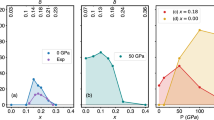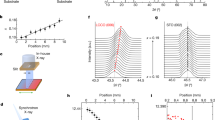Abstract
Plutonium is a metal of both technological relevance and fundamental scientific interest. Nevertheless, the electronic structure of plutonium, which directly influences its metallurgical properties1, is poorly understood. For example, plutonium's 5f electrons are poised on the border between localized and itinerant, and their theoretical treatment pushes the limits of current electronic structure calculations2. Here we extend the range of complexity exhibited by plutonium with the discovery of superconductivity in PuCoGa5. We argue that the observed superconductivity results directly from plutonium's anomalous electronic properties and as such serves as a bridge between two classes of spin-fluctuation-mediated superconductors: the known heavy-fermion superconductors and the high-Tc copper oxides. We suggest that the mechanism of superconductivity is unconventional; seen in that context, the fact that the transition temperature, Tc ≈ 18.5 K, is an order of magnitude greater than the maximum seen in the U- and Ce-based heavy-fermion systems may be natural. The large critical current displayed by PuCoGa5, which comes from radiation-induced self damage that creates pinning centres, would be of technological importance for applied superconductivity if the hazardous material plutonium were not a constituent.



Similar content being viewed by others
References
Hecker, S. S. The complex world of plutonium science. MRS Bull. 26, 672–678 (2001)
Savrasov, S. Y., Kotliar, G. & Abrahams, E. Correlated electrons in δ-plutonium within a dynamical mean-field picture. Nature 410, 793–795 (2001)
Grin, Yu. N., Rogl, P. & Hiebl, K. Structural chemistry and magnetic behavior of ternary uranium gallides U(Fe,Co,Ni,Ru,Rh,Pd,Os,Ir,Pt)-Ga5 . J. Less Common Met. 121, 497–505 (1986)
Petrovic, C. et al. Heavy-fermion superconductivity in CeCoIn5 at 2.3 K. J. Phys. Condens. Matt. 13, L337–L342 (2001)
Wick, O. J. (ed.) Plutonium Handbook: a Guide to the Technology 33–57 (American Nuclear Society, LaGrange Park, IL, 1980)
Stewart, G. R. & Elliott, R. O. Actinides in Perspective Abstracts Lawrence Berkeley Laboratory Report no. 12441 206–207 (Lawrence Berkeley National Laboratory, Berkeley, CA, 1981)
Nagamatsu, J., Nakagawa, N., Muranaka, T., Zenitani, Y. & Akimitsu, J. Superconductivity at 39 K in magnesium diboride. Nature 410, 63–64 (2001)
Werthamer, N. R., Helfand, E. & Hohenberg, P. C. Temperature and purity dependence of the superconducting critical field, Hc2. III. Electron spin and spin-orbit effects. Phys. Rev. 147, 295–302 (1966)
Clogston, A. M. Upper limit for the critical field in hard superconductors. Phys. Rev. Lett. 9, 266 (1962)
Bean, C. P. Magnetization of hard superconductors. Phys. Rev. Lett. 8, 250–253 (1962)
Wolfer, W. G. Radiation effects in plutonium. Los Alamos Sci. 26, 274–285 (2000)
Campbell, A. M. & Evetts, J. E. Flux vortices and transport currents in type II superconductors. Adv. Phys. 21, 199–427 (1972)
Tokiwa, Y. et al. Magnetic and Fermi surface properties of UPtGa5 . J. Phys. Soc. Jpn 71, 845–851 (2002)
Mathur, N. D. et al. Magnetically mediated superconductivity in heavy fermion compounds. Nature 394, 39–43 (1998)
Acknowledgements
We thank Z. Fisk and C. Varma for discussions. Work at Los Alamos and Florida was performed under the auspices of the US Department of Energy.
Author information
Authors and Affiliations
Corresponding author
Ethics declarations
Competing interests
The authors declare that they have no competing financial interests.
Rights and permissions
About this article
Cite this article
Sarrao, J., Morales, L., Thompson, J. et al. Plutonium-based superconductivity with a transition temperature above 18 K. Nature 420, 297–299 (2002). https://doi.org/10.1038/nature01212
Received:
Accepted:
Issue Date:
DOI: https://doi.org/10.1038/nature01212
- Springer Nature Limited
This article is cited by
-
Piezomagnetic switching and complex phase equilibria in uranium dioxide
Communications Materials (2021)
-
Electronic structure of LaIrIn5 and f-electron character in its related Ce-115 compounds
Science China Physics, Mechanics & Astronomy (2020)
-
Multiple superconducting phases in a nearly ferromagnetic system
Communications Physics (2019)
-
Theory of nodal s±-wave pairing symmetry in the Pu-based 115 superconductor family
Scientific Reports (2015)





